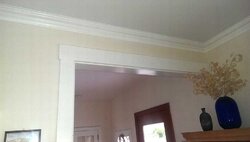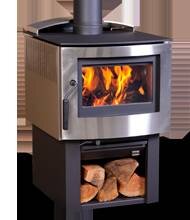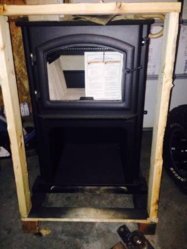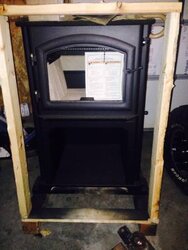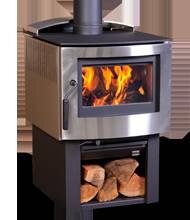(Skip to the last paragraph if you want to get to the point; the rest is just relevant info on my situation).
Hello all,
I've been doing some searching about stoves, and have determined that this forum is the most informative place on the net. We bought a house a year ago, and I'm finding our current wood stove's performance inadequate. We have a 2200 sq ft house with two stories. The stove is in the extreme corner of the house in the living room, nestled between two exterior walls. The pipe/chimney run is straight up, and probably tops out at 26' off the ground. It's on the windward side of the house (west), with some trees around. Sometimes I think this causes some positive pressure outside that gives us draft troubles when starting up cold, but it's fine after a few minutes.
The main problem is the inability to achieve long burn times, and the lack of heat distribution in the house. This thing will chase you out of the living room, but the entire upstairs is cold, and the rest of the house stays cool. The house doesn't have a very open layout, and I think the transom of the living room is blocking the heat flow. The firebox lacks height; I can't stack two 5" splits in there! This stove is just too small for this house. Maybe they just purchased it for ambiance? We have a modern gas furnace with forced air, but would prefer to use it sparingly.
I'm thinking this stove needs to be in a more central location. If I move it to the entry way (which would require a reduced-clearance install), it would be near the opening of the living room, the stairwell, the downstairs hall, and the dining/kitchen area. This sounds more effective to me. I also figured I should shoot for something bigger--I'm thinking 3 cu ft. I want to be able to wake up to a somewhat warm house, stoke, reload, and keep our new baby comfortable (without using so much gas).
So, I've started stove shopping. I'm in love with the Alderlea T6. I like the idea of the cooktop, but admittedly, probably wouldn't use it much. Even with our inevitable rural power outages, we have propane stoves. The T6 is $$$ though. I also kinda like some of the hearthstone models, but again, $$$.
So to get to the point, there's a 1995 Mansfield on CL in my area. It looks a little sooty around the door, and doesn't have the side-load door either. Other than that, it looks similar to current models. My big question is, can I expect the same emissions, efficiency, burn time, BTUs, etc out of this older model? The guy is fairly proud of it and is asking $2200 (he thinks including a Magic Heat creosote condenser is real special). I'd have to get him down in price, but he says it was used seldomly. Should I be concerned spending so much on such an old stove, or is it worth it if is in good shape? Also, how hard is it to clean the soot off of those soap stones? Could I make this thing look newer with little effort?
Hello all,
I've been doing some searching about stoves, and have determined that this forum is the most informative place on the net. We bought a house a year ago, and I'm finding our current wood stove's performance inadequate. We have a 2200 sq ft house with two stories. The stove is in the extreme corner of the house in the living room, nestled between two exterior walls. The pipe/chimney run is straight up, and probably tops out at 26' off the ground. It's on the windward side of the house (west), with some trees around. Sometimes I think this causes some positive pressure outside that gives us draft troubles when starting up cold, but it's fine after a few minutes.
The main problem is the inability to achieve long burn times, and the lack of heat distribution in the house. This thing will chase you out of the living room, but the entire upstairs is cold, and the rest of the house stays cool. The house doesn't have a very open layout, and I think the transom of the living room is blocking the heat flow. The firebox lacks height; I can't stack two 5" splits in there! This stove is just too small for this house. Maybe they just purchased it for ambiance? We have a modern gas furnace with forced air, but would prefer to use it sparingly.
I'm thinking this stove needs to be in a more central location. If I move it to the entry way (which would require a reduced-clearance install), it would be near the opening of the living room, the stairwell, the downstairs hall, and the dining/kitchen area. This sounds more effective to me. I also figured I should shoot for something bigger--I'm thinking 3 cu ft. I want to be able to wake up to a somewhat warm house, stoke, reload, and keep our new baby comfortable (without using so much gas).
So, I've started stove shopping. I'm in love with the Alderlea T6. I like the idea of the cooktop, but admittedly, probably wouldn't use it much. Even with our inevitable rural power outages, we have propane stoves. The T6 is $$$ though. I also kinda like some of the hearthstone models, but again, $$$.
So to get to the point, there's a 1995 Mansfield on CL in my area. It looks a little sooty around the door, and doesn't have the side-load door either. Other than that, it looks similar to current models. My big question is, can I expect the same emissions, efficiency, burn time, BTUs, etc out of this older model? The guy is fairly proud of it and is asking $2200 (he thinks including a Magic Heat creosote condenser is real special). I'd have to get him down in price, but he says it was used seldomly. Should I be concerned spending so much on such an old stove, or is it worth it if is in good shape? Also, how hard is it to clean the soot off of those soap stones? Could I make this thing look newer with little effort?


